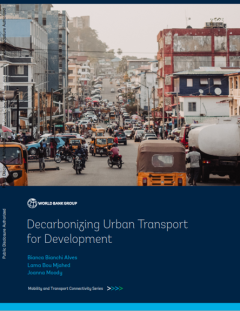Ditapis dengan

DECARBONIZING URBAN TRANSPORT FOR DEVELOPMENT
The path to low-carbon urban transport looks fundamentally different in developed and developing countries. Most cities in developing countries have not yet developed their land use and transportation infrastructure around cars, leaving a window of opportunity to chart a new path to low-carbon, efficient and inclusive urban transport. While developed countries may focus on retrofitting existing…
- Edisi
- -
- ISBN/ISSN
- -
- Deskripsi Fisik
- -
- Judul Seri
- -
- No. Panggil
- 388 BIA d

GIF GUIDANCE : CLEAN TECHNOLOGY OPTIONS FOR BUSES - PREFEASIBILITY ANALYSIS
This guide begins by establishing the minimum conditions that should be in place to consider a technology feasible. This will be done in chapter two, starting with the general local political context and analysis of the project’s planning, and moving on to more specific technical conditions for each technology regarding energy vector availability and standards and regulations to consider. Onc…
- Edisi
- -
- ISBN/ISSN
- -
- Deskripsi Fisik
- -
- Judul Seri
- -
- No. Panggil
- 388 BIA g

ADAPTING MOBILITY-AS-A-SERVICE FOR DEVELOPING CITIES : A CONTEXT-SENSITIVE AP…
People living in cities have more mobility options than ever before. Making the most out of expanding travel choices for cities and their residents will require integration among different mobility services. Mobility-as-a-Service (MaaS) can provide an organizing framework for integrating multiple mobility options and shaping how they can work together to provide a more seamless travel experienc…
- Edisi
- -
- ISBN/ISSN
- -
- Deskripsi Fisik
- -
- Judul Seri
- -
- No. Panggil
- 388 BIA a
 Karya Umum
Karya Umum  Filsafat
Filsafat  Agama
Agama  Ilmu-ilmu Sosial
Ilmu-ilmu Sosial  Bahasa
Bahasa  Ilmu-ilmu Murni
Ilmu-ilmu Murni  Ilmu-ilmu Terapan
Ilmu-ilmu Terapan  Kesenian, Hiburan, dan Olahraga
Kesenian, Hiburan, dan Olahraga  Kesusastraan
Kesusastraan  Geografi dan Sejarah
Geografi dan Sejarah